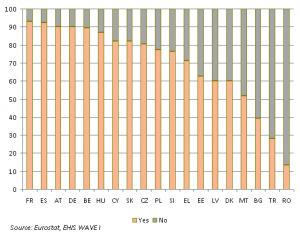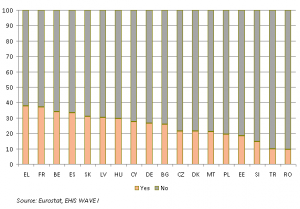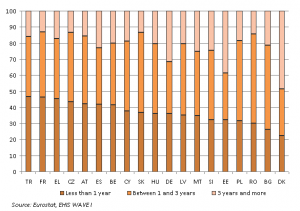Archive:Breast cancer screening statistics
- Data from Month Year. Most recent data: Further Eurostat information, Main tables and Database.
<Introduction: simple language, not too long, kind of executive summary>

Introduction
Cancer of the breast is one of the most common types of cancer among women worldwide. In 2009, the standardized death rate of breast cancer for the EU-27 stood at 23.1 deaths per 100 000 inhabitants[1].
In 2003, the European Parliament (EP) adopted a Resolution (A5-0159/2003[2]) to combat breast cancer and made it a priority in EU health policy. The resolution stated that '…Every woman should have access to high-quality screening treatment, and any disparities in access should be minimized….' Apart from other calls on Member States, the EP also sought then to reduce mortality from breast cancer by 25% and the disparity rate by 5% in European Union countries and this to be achieved by 2008[3]. It also promoted the provision of breast cancer screening for all women aged 50-69 years every two years.
Data sources and availability
Data from European Health Interview Survey (EHIS) Wave I were published in Eurostat Website in 2011. Few graphs based on breast cancer screening variables are set out below. EHIS only asks for a breast cancer screening that is carried out by mammography (=mamma (breast) + graph (picture)). Seventeen countries sent micro data to Eurostat. Austrian data on mammography are not reliable for the age group less than 50 years old. Some aggregated data were received from Denmark and Germany. In England, only administrative data are available and figures are based on the report Breast Screening Programme, England 2010-2011. The reference years for the 17 countries in the EHIS survey vary. Most of the countries launched the survey in 2008.
Main statistical findings
The breast-cancer screening programmes are required to abide by European Guidelines. In 2006, the European Commission published the 4th edition of the European Guidelines for Quality Assurance in Breast Cancer screening and organization of diagnosis[4]. The aim of the Guidelines is to put in place recommended standards and procedures for implementing breast screening programmes in the European Union, as well as ensuring the quality of breast cancer services outside of those programmes. The Guidelines also include a list of performance indicators, including promoting the proportion of women invited to attend screening, which should be between 70 – 75 % of eligible women[5] in European countries. The European Guidelines are not binding, and it is up to the Member States to decide how those standards are to be incorporated into national or regional systems. The risk of breast cancer increases with age, family cancer history, unusual hormonal and reproductive factors, unhealthy life style and many
other factors. With demographic changes and an older population, more women will be confronted with breast cancer. Prevention and early detection are very important. There are three forms of breast examination: a mammogram (X-ray of the breast by a specialist), a clinical examination of the breast (by a doctor or a nurse to look for changes or lumps) and self-examination of the breast. Women aged from 50 to 69 are usually called to undergo a mammogram every two or three years. Any woman who has reached the age of 53 should have had at least one mammogram by then. Nowadays there is a growing tendency to extend screening activities for the remaining age groups, i.e. those aged less than 50 and women over 69[6]. Breast cancer screening by mammography is very costly. This might have an impact on the availability of mammography units in some countries.
Figures 1 and 2 show the percentage of women who have ever undergone an mammography[7]. Figure 1 shows the women aged between 50 and 69. Among the countries studied, France has the highest proportion (92.9 %), followed by Spain (92.3 %), Austria and Germany (90 %), Belgium (89.5 %) and Hungary (86.9 %). The proportion of women who underwent screening was lowest in Turkey (28.1 %) and Romania (13.5 %). In England the data of 2009 show that 76.5 % of all eligible women aged 50-70 had undertaken examination within the last 3 years.
Figure 2 shows data for women under 50. Among the countries studied, Greece is top of the list with nearly 38 %, followed by France (37.2 %) and Belgium (34.2 %).
As in Figure 1, Turkey and Romania account for the lowest share, with less than 10 % of women undergoing a mammography.
In line with the recommendation to undergo a mammography every two or three years, Figure 3 shows the percentage distribution of the mammography for women of all ages (starting 15+) who had ever undergone the examination within either the past 12 months either in more than one year, but not more than three years or in 3 years ago and more[8]. For many countries Figure 3 illustrates large proportions of mammography within one year or three years.
Under the EHIS survey, if a woman had ever undergone a mammography, she was also asked what her reasons for doing so were[9]. Figure 4 shows the largest percentage of all women (15+) who were invited by national or regional screening programmes were in Hungary (55,1 % invited by programme) and Spain (43,5 % by programme). The lowest share below than 5 % participation was in Malta (only 3,6 % by programme meanwhile 96,4 % by other initiative) and Slovak Republic (1,2 % invited by programme and 98,9 % by other initiative). In England, from all women screened, 94.7 % were invited by screening progamme during 2009-2010[10].
There were no declared cases of women having been invited as part of the national screening programme in Latvia. In Latvia the EHIS survey was launched in 2008 meanwhile the national breast cancer screening programme was implemented one year later, in 2009.The variable asking for a reason of mammography was not included in the survey in France and Austria. Austria runs since 1974 opportunistic screening[11]: examination is conducted in non-dedicated mammography screening centers without active invitation neither control system . In Denmark a national screening programme was introduced in 2007 meanwhile the Health Interview Survey was launched in 2005. In Greece, national breast-cancer screening programme was not implemented yet and some pilot projects run since 1988. In Slovak Republic preparatory steps for an implementation of a national breast-cancer screening programme began in 2008.
For a number of countries, there are differences in having mammography by educational status. Figure 5 shows the percentage distribution of women aged 50-69 years ever screened by mammography, by educational status. The first category (ED0-2) represents those women having ‘pre-primary, primary or lower secondary education. The next category (ED3_4) covers those with an ‘upper secondary or post-secondary non-tertiary education’ and the last category (ED5_6) includes those who have completed the ‘first or second stage of tertiary education’. Data of Germany for the first category the educational status is not available.
The gap between the top category and bottom categories is very large in Turkey and Bulgaria. It is especially marked in Turkey where participation in mammography among women aged 50-69 with the highest educational status (ED5_6) is 73.2 %, while for the lower educational status (ED0-2) it is only 23.9 %. There is a difference of more than 20 % between the top and bottom educational levels in Czech Republic, Romania, Latvia, Poland, Greece and Slovenia. Spain, France and Belgium have the lowest inequalities by educational level.
Further Eurostat information
Publications
Main tables
- Title(s) of second level folder (if any)
- Title(s) of third level folder (if any)
Database
- Title(s) of second level folder (if any)
- Title(s) of third level folder (if any)
Dedicated section
Methodology / Metadata
<link to ESMS file, methodological publications, survey manuals, etc.>
- Name of the destination ESMS metadata file (ESMS metadata file - ESMS code, e.g. bop_fats_esms)
- Title of the publication
Source data for tables, figures and maps (MS Excel)
Other information
<Regulations and other legal texts, communications from the Commission, administrative notes, Policy documents, …>
- Regulation 1737/2005 (generating url [http://eur-lex.europa.eu/LexUriServ/LexUriServ.do?uri=CELEX:32005R1737:EN:NOT Regulation 1737/2005]) of DD Month YYYY on ...
- Directive 2003/86/EC (generating url [http://eur-lex.europa.eu/LexUriServ/LexUriServ.do?uri=CELEX:32003L0086:EN:NOT Directive 2003/86/EC]) of DD Month YYYY on ...
- Commission Decision 2003/86/EC (generating url [http://eur-lex.europa.eu/LexUriServ/LexUriServ.do?uri=CELEX:32003D0086:EN:NOT Commission Decision 2003/86/EC]) of DD Month YYYY on ...
<For other documents such as Commission Proposals or Reports, see EUR-Lex search by natural number>
<For linking to database table, otherwise remove: {{{title}}} ({{{code}}})>
External links
See also
Notes
- ↑ Eurostat database table: hlth_cd_asdr
- ↑ European Parliament resolution A5-0159/2003 (Url link: http://www.europarl.europa.eu/sides/getDoc.do?type=REPORT&amp;amp;amp;amp;amp;amp;reference=A5-2003-0159&amp;amp;amp;amp;amp;amp;language=EN
- ↑ The standardised death rate of breast cancer in 2003 was 25.5 deaths per 100000 inhabitants in EU27, in 2008 this rate was 23.9. Thus there is decreased only by around 6.7 % during 2003-2008 in EU27.
- ↑ European Guidelines for Quality Assurance in Breast Cancer screening and diagnosis (Url link:http://ec.europa.eu/health/archive/ph_projects/2002/cancer/fp_cancer_2002_ext_guid_01.pdf)
- ↑ Eligible women are women who should be invited by national breast cancer screening programmes.
- ↑ NHS report Breast Screening Programme, England 2010-11: In England (in April 2011) the age range was extended to include women aged 65-70. In December 2007 it was announced that the age at which women are screened would be extended again, incorporating ages of 47 and 73 years. This will ensure all women receive their first invitation for screening before the age of 50. The programme is now phasing in the extension. This started in 2010 and full roll-out is expected to be completed after 2016.
- ↑ EHIS WAVE I variable PA10: [Have you ever had a mammography, which is an X-ray of one or both of your breasts? (Answers: Yes, No).]
- ↑ EHIS WAVE I variable PA11: When was the last time you had a mammography (breast X-ray)? (Answers: Within the past 12 months, More than 1 year, but not more than 2 years, More than 2 years, but not more than 3 years, Not within the past 3 years ).]
- ↑ EHIS WAVE I variable PA12: [What was the reason for the last mammography?]
- ↑ Source: NHS report Breast Screening Programme, England 2010-11.
- ↑ Source: Medical University of Vienna
[[Category:<Under construction>|Name of the statistical article]]
[[Category<Subtheme category name(s)>|Name of the statistical article]] [[Category:<Statistical article>|Name of the statistical article]]




